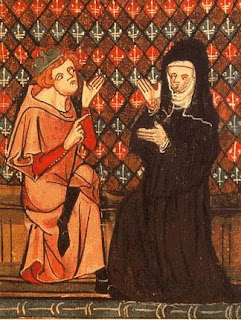IN CONVERSATION WITH THE COSMOS: Hildegard of Bingen (1098-1179)
TO READ: Mystics, Visionaries & Prophets, Chapter 6
Medieval Women Writers, “The German Visionary, Hildegard of Bingen”
What does it mean to know God? What gives life meaning? When I ask such questions to my Christian friends, the answer inevitably revolves around the need to act. As a student of cultures, this does not surprise me. Western civilization is activist: building, questing, inventing, imagining, organizing, crusading, struggling, desiring, succeeding, failing. Like the Church, activism is a gift from the Middle Ages, and its most famous religious avatar is that contemporary of both Hildegard and Heloise, Bernard of Clairvaux, who from the heights of his own contemplative life preached two Crusades: the disastrous Second Crusade in the Holy Land and the “cleansing” crusades against the Albigensian heresy in the South of France. All of which is to warn: external activism may be more likely to get you into trouble than save the world.
For salvation at this time we must turn to a woman. Hildegard of Bingen incarnates a different strand of Western thought, universally admired, but, sadly, rarely followed, which places the cultivation of enlightenment through meditation and contemplation at the heart of the spiritual life. Her community of nuns practiced the Christian answer to Buddha’s Middle Way, life in moderation, an understanding of illness and suffering as distress in both body and soul–Hildegard was a brilliant psychologist–and an outpouring of music and art to impress the virtues of Christian life upon the heart.
Again, like Buddha under the Bodhi Tree, Hildegard received clear, waking visions of reality, past and future. To the hierarchical and combative world view of her masculine counterparts, she offers the wisdom of sacred circles, and for her, the End Times begin, not with heavenly armies, but the violation of the feminine by the Beast.
Visionary writing can make difficult reading. Therefore, I have attached some images which go with what are included in our texts. If you do nothing else this week, spend some time with them and let them awaken things in you. They may or may not be the same things they awakened in her. All good sacred images and texts carry layers of meaning.
Of her visions, she wrote in a letter to Guibert of Gembloux, “I observe them according to the vicissitudes of clouds and other created things. I do not hear these things, however, with my external ears, nor do I perceive them by the thoughts of my heart, nor by any combination of my five senses–but rather in my soul, with my external eyes open, so that I have never suffered the weakness of ecstasy in them, but alertly see them by day and by night.” A beautiful image of mindfulness.
You can listen to a musical setting of Ordo Virtutem here: https://www.youtube.com/watch?v=WBGgRSPyUFQ
Another setting of the same piece: https://www.youtube.com/watch?v=RhrvSE05WPc
See you Wednesday, October 3
Meg and Carol



Comments
Post a Comment